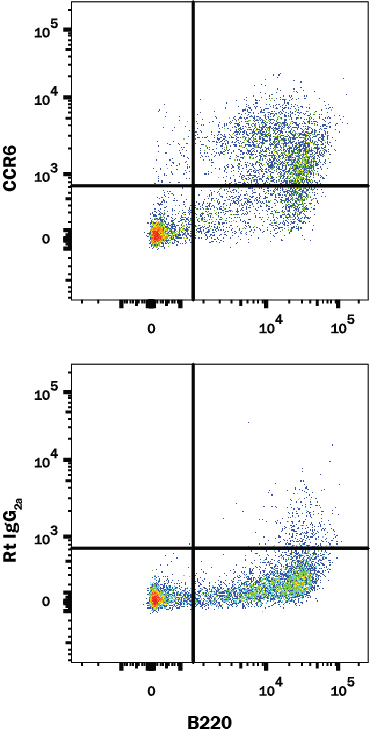Mouse CCR6 Antibody Summary
Met1-Met367
Accession # O54689
Applications
Please Note: Optimal dilutions should be determined by each laboratory for each application. General Protocols are available in the Technical Information section on our website.
Scientific Data
 View Larger
View Larger
Detection of CCR6 in Mouse Splenocytes by Flow Cytometry. Mouse splenocytes were stained with (A) Rat Anti-Mouse CCR6 Monoclonal Antibody (Catalog # MAB590) or (B) Rat IgG2A control antibody (Catalog # MAB006) followed by Goat anti-Rat IgG APC-conjugated Secondary Antibody (Catalog # F0113) and Rat Anti-Mouse B220/CD45R Fluorescein-conjugated Monoclonal Antibody (Catalog # FAB1217F). View our protocol for Staining Membrane-associated Proteins.
 View Larger
View Larger
CCR6 in Mouse Thymus. CCR6 was detected in perfusion fixed frozen sections of mouse thymus using Mouse CCR6 Monoclonal Antibody (Catalog # MAB590) at 8 µg/mL overnight at 4 °C. Tissue was stained using the Anti-Rat HRP-DAB Cell & Tissue Staining Kit (brown; Catalog # CTS017) and counterstained with hematoxylin (blue). Specific labeling was localized to the plasma membrane of lymphocytes. View our protocol for Chromogenic IHC Staining of Frozen Tissue Sections.
 View Larger
View Larger
CCR6 in Mouse Spleen. CCR6 was detected in immersion fixed frozen sections of mouse spleen using Rat Anti-Mouse CCR6 Monoclonal Antibody (Catalog # MAB590) at 0.3 µg/mL overnight at 4 °C. Tissue was stained using the Anti-Rat HRP-DAB Cell & Tissue Staining Kit (brown; Catalog # CTS017) and counterstained with hematoxylin (blue). Specific staining was localized to plasma membranes in lymphocytes. View our protocol for Chromogenic IHC Staining of Frozen Tissue Sections.
Reconstitution Calculator
Preparation and Storage
- 12 months from date of receipt, -20 to -70 °C as supplied.
- 1 month, 2 to 8 °C under sterile conditions after reconstitution.
- 6 months, -20 to -70 °C under sterile conditions after reconstitution.
Background: CCR6
CCR6 is a seven transmembrane-spanning G protein-coupled receptor that binds the chemokine MIP-3 alpha and mediates the chemoattraction of B and T lymphocytes.
Product Datasheets
Citations for Mouse CCR6 Antibody
R&D Systems personnel manually curate a database that contains references using R&D Systems products. The data collected includes not only links to publications in PubMed, but also provides information about sample types, species, and experimental conditions.
9
Citations: Showing 1 - 9
Filter your results:
Filter by:
-
IL-1? and IL-23 Promote Extrathymic Commitment of CD27(+)CD122(-) ?? T Cells to ??T17 Cells
Authors: A Muschaweck, F Petermann, T Korn
J. Immunol., 2017-08-30;0(0):.
Species: Mouse
Sample Types: Whole Cells
Applications: Flow Cytometry -
IL-10+ Innate-like B Cells Are Part of the Skin Immune System and Require ?4?1 Integrin To Migrate between the Peritoneum and Inflamed Skin
Authors: SA Geherin, D Gómez, RA Glabman, G Ruthel, A Hamann, GF Debes
J. Immunol, 2016-02-05;196(6):2514-25.
Species: Mouse
Sample Types: Whole Cells
Applications: Flow Cytometry -
The chemokine receptor CCR6 facilitates the onset of mammary neoplasia in the MMTV-PyMT mouse model via recruitment of tumor-promoting macrophages.
Authors: Boyle S, Faulkner J, McColl S, Kochetkova M
Mol Cancer, 2015-06-06;14(0):115.
Species: Mouse
Sample Types: Tissue Homogenates
Applications: ELISA Development (Capture) -
CCR6 is a prognostic marker for overall survival in patients with colorectal cancer, and its overexpression enhances metastasis in vivo.
Authors: Liu, Jinlin, Ke, Fang, Xu, Zhenyao, Liu, Zhaoyuan, Zhang, Lingyun, Yan, Sha, Wang, Zhe, Wang, Hong, Wang, Honglin
PLoS ONE, 2014-06-30;9(6):e101137.
Species: Mouse
Sample Types: In Vivo
Applications: Neutralization -
SerpinB1 regulates homeostatic expansion of IL-17+ gammadelta and CD4+ Th17 cells.
Authors: Zhao P, Hou L, Farley K, Sundrud M, Remold-O'Donnell E
J Leukoc Biol, 2013-11-18;95(3):521-30.
Species: Mouse
Sample Types: Whole Cells
Applications: Flow Cytometry -
Programmed downregulation of CCR6 is important for establishment of epidermal gammadeltaT cells by regulating their thymic egress and epidermal location.
Authors: Hu S, Xiong N
J Immunol, 2013-02-18;190(7):3267-75.
Species: Mouse
Sample Types: Whole Cells
Applications: Flow Cytometry -
Colonic patch and colonic SILT development are independent and differentially regulated events.
Authors: Baptista A, Olivier B, Goverse G, Greuter M, Knippenberg M, Kusser K, Domingues R, Veiga-Fernandes H, Luster A, Lugering A, Randall T, Cupedo T, Mebius R
Mucosal Immunol, 2012-09-19;6(3):511-21.
Species: Mouse
Sample Types: Whole Tissue
Applications: IHC -
CCR6 is required for epidermal trafficking of gammadelta-T cells in an IL-23-induced model of psoriasiform dermatitis.
Authors: Mabuchi T, Singh T, Takekoshi T, Jia G, Wu X, Kao M, Weiss I, Farber J, Hwang S
J Invest Dermatol, 2012-08-16;133(1):164-71.
Species: Mouse
Sample Types: Whole Tissue
Applications: IHC-Fr -
Human beta-defensin 2 and 3 and their mouse orthologs induce chemotaxis through interaction with CCR2.
Authors: Rohrl J, Yang D, Oppenheim JJ, Hehlgans T
J. Immunol., 2010-05-17;184(12):6688-94.
Species: Mouse
Sample Types: Whole Cells
Applications: Flow Cytometry
FAQs
No product specific FAQs exist for this product, however you may
View all Antibody FAQsReviews for Mouse CCR6 Antibody
Average Rating: 5 (Based on 1 Review)
Have you used Mouse CCR6 Antibody?
Submit a review and receive an Amazon gift card.
$25/€18/£15/$25CAN/¥75 Yuan/¥2500 Yen for a review with an image
$10/€7/£6/$10 CAD/¥70 Yuan/¥1110 Yen for a review without an image
Filter by:




